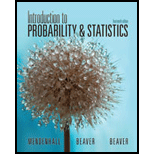Solutions for Introduction to Probability and Statistics
Browse All Chapters of This Textbook
Book Details
Used by hundreds of thousands of students, INTRODUCTION TO PROBABILITY AND STATISTICS, Fourteenth Edition, blends proven coverage with new innovations to ensure you gain a solid understanding of statistical concepts--and see their relevance to your everyday life. The new edition retains the text's straightforward presentation and traditional outline for descriptive and inferential statistics while incorporating modern technology--including computational software and interactive visual tools--to help you master statistical reasoning and skillfully interpret statistical results. Drawing from decades of classroom teaching experience, the authors clearly illustrate how to apply statistical procedures as they explain how to describe real sets of data, what statistical tests mean in terms of practical application, how to evaluate the validity of the assumptions behind statistical tests, and what to do when statistical assumptions have been violated. Statistics can be an intimidating course, but with this text you will be well prepared. With its thorough explanations, insightful examples, practical exercises, and innovative technology features, this text equips you with a firm foundation in statistical concepts, as well as the tools to apply them to the world around you.
Sample Solutions for this Textbook
We offer sample solutions for Introduction to Probability and Statistics homework problems. See examples below:
More Editions of This Book
Corresponding editions of this textbook are also available below:
